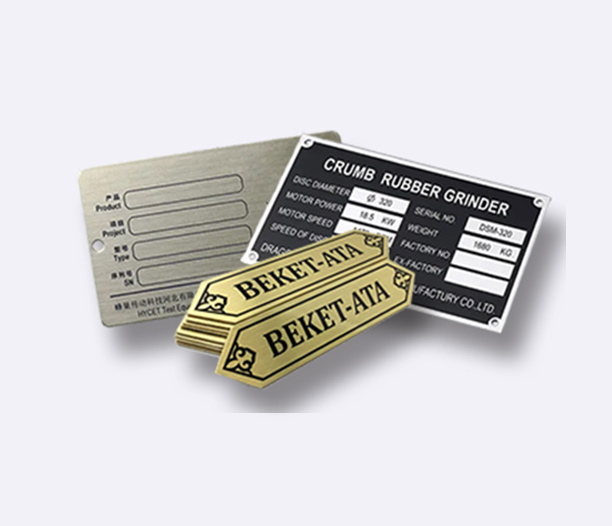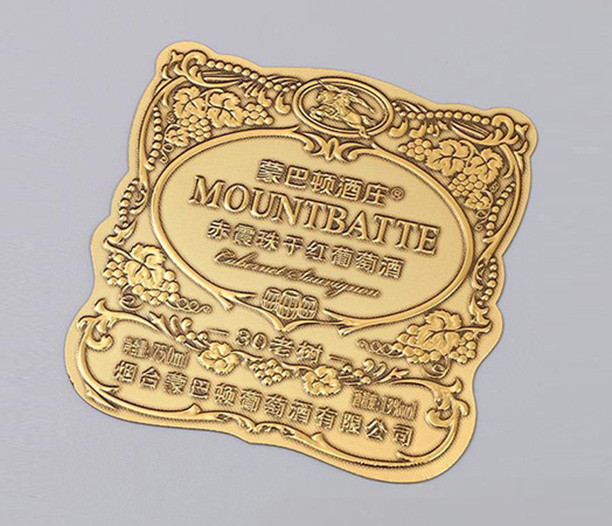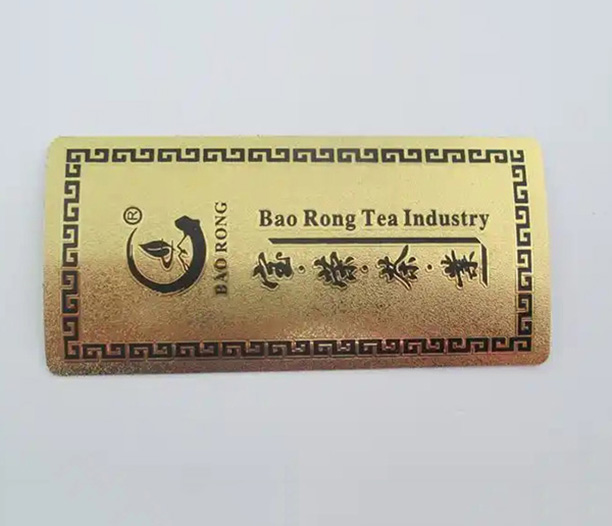If you’ve ever glanced at a piece of machinery, a consumer product, or even a military vehicle, chances are you’ve seen an aluminum nameplate. These unassuming metal tags are everywhere—but what exactly do they do? Far more than just labels, aluminum nameplates serve critical roles in identification, branding, compliance, and safety across industries. In this deep dive, we’ll explore their diverse applications, unique advantages, and why they’re the go-to choice for engineers, designers, and manufacturers worldwide.
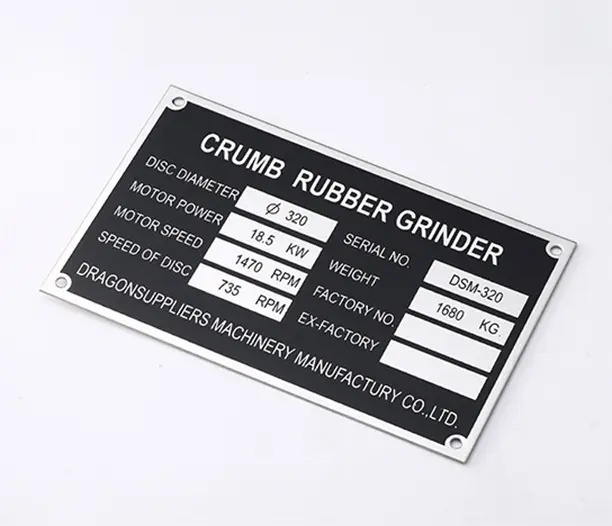
The Basics: What Makes Aluminum Nameplates Special?
Aluminum nameplates are thin, flat tags made from aluminum alloy, often treated for durability and customized with text, logos, or codes. Their popularity stems from three key traits:
- Lightweight: Aluminum is 3x lighter than steel, making it ideal for portable devices.
- Corrosion-Resistant: Anodized or coated finishes protect against rust, chemicals, and UV damage.
- Easily Customizable: They can be stamped, etched, engraved, or printed with precision.
But where exactly do these properties shine? Let’s break it down.
Top 10 Uses of Aluminum Nameplates
1. Industrial Equipment Identification
In factories and plants, aluminum nameplates act as “birth certificates” for machinery. They display:
- Model and serial numbers.
- Manufacturing dates.
- Safety certifications (e.g., UL, CE).
- Electrical ratings (voltage, wattage).
Why Aluminum? Resists oil, coolant, and heat—common in industrial environments.
2. Aerospace and Defense Tagging
From fighter jets to satellites, aluminum nameplates survive extreme conditions:
- High-altitude temperature swings.
- Jet fuel exposure.
- Vibration and impact.
They often include QR codes for tracking part histories and maintenance schedules.
3. Medical Device Labeling
Hospital equipment like MRI machines and surgical tools rely on aluminum nameplates for:
- Sterilization compliance (withstands autoclaves).
- Patient safety data (e.g., radiation warnings).
- Asset tracking in large facilities.
Bonus: Antimicrobial coatings prevent bacterial growth.
4. Consumer Electronics Branding
Your laptop, smartphone, or gaming console likely has a sleek aluminum nameplate for:
- Brand logos (Apple’s iconic “MacBook” engraving).
- Regulatory marks (FCC ID, recycling symbols).
- Serial numbers for warranties.
Anodized finishes match modern aesthetics while resisting scratches.
5. Automotive and EV Components
Under the hood, aluminum nameplates label:
- Engine parts (e.g., VIN plates).
- Battery specs for electric vehicles.
- Tire pressure ratings.
They’re also used for luxury branding (e.g., Mercedes-Benz hood emblems).
6. Military Asset Tracking
The U.S. military uses aluminum nameplates to tag:
- Weapons systems.
- Vehicles (tanks, Humvees).
- Communication gear.
Etched codes survive sand, mud, and combat wear.
7. Marine and Offshore Applications
Saltwater is a metal’s worst enemy—except for aluminum nameplates with marine-grade coatings. They’re used on:
- Ship engines.
- Oil rig components.
- Navigation equipment.
8. Construction and Architectural Signage
In buildings, aluminum nameplates serve as:
- Fire escape route markers.
- Elevator inspection tags.
- Custom room numbers or donor plaques.
Powder-coated finishes withstand weather on outdoor installations.
9. Retail and Hospitality Branding
High-end hotels and stores use aluminum nameplates for:
- Luxury product tags (watches, handbags).
- Desk nameplates for executives.
- Directional signage in lobbies.
Brushed or polished finishes convey premium quality.
10. Renewable Energy Systems
Solar panels, wind turbines, and battery arrays use aluminum nameplates to display:
- Energy output specs.
- Installation dates.
- QR codes linked to maintenance manuals.
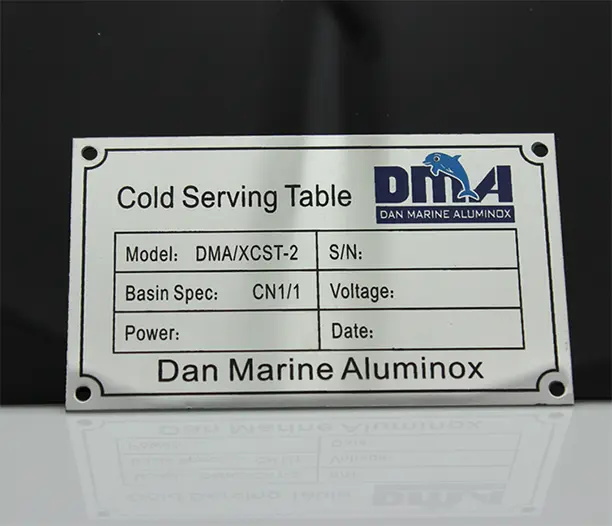
Why Choose Aluminum Over Other Materials?
vs. Stainless Steel
- Aluminum Wins: Lighter, cheaper, and better for intricate designs.
- Steel Wins: Higher strength for extreme loads.
vs. Plastic
- Aluminum Wins: Far more durable, heat-resistant, and eco-friendly.
- Plastic Wins: Lower cost for disposable labels.
vs. Brass
- Aluminum Wins: Doesn’t tarnish, lighter, and budget-friendly.
- Brass Wins: Classic look for decorative plaques.
Customization Options for Aluminum Nameplates
- Engraving: Laser or rotary etching for permanent text.
- Screen Printing: Vibrant colors for logos or warnings.
- Embossing/Debossing: 3D lettering for tactile labels.
- Barcodes/QR Codes: Track assets or link to digital manuals.
- Specialty Finishes: Matte, glossy, or textured surfaces.
Case Study: How Aluminum Nameplates Saved a Manufacturing Plant $50k/year
- Problem: A factory’s paper labels faded quickly, causing mislabeled parts and production delays.
- Solution: They switched to aluminum nameplates with laser-etched codes.
- Result: Reduced relabeling costs by 80% and cut downtime by 30%.
Sustainability: The Eco-Friendly Edge of Aluminum Nameplates
- Recyclable: Aluminum can be reused indefinitely without quality loss.
- Low Waste: Precision cutting minimizes material scraps.
- Long Lifespan: Outlasts plastic labels by decades, reducing landfill waste.
Future Trends in Aluminum Nameplates
- Smart Tags: NFC-enabled plates for real-time IoT tracking.
- Self-Healing Coatings: Scratch-resistant surfaces that repair minor damage.
- Thinner, Stronger Alloys: Ultra-light tags for wearable tech and drones.
What Are Aluminum Nameplates Used For?
From factory floors to luxury boutiques, aluminum nameplates are the silent workhorses of identification and branding. Their blend of durability, customization, and cost-effectiveness makes them indispensable across industries. Whether you’re tracking a spaceship part or polishing a designer handbag’s logo, aluminum delivers where other materials fail.



